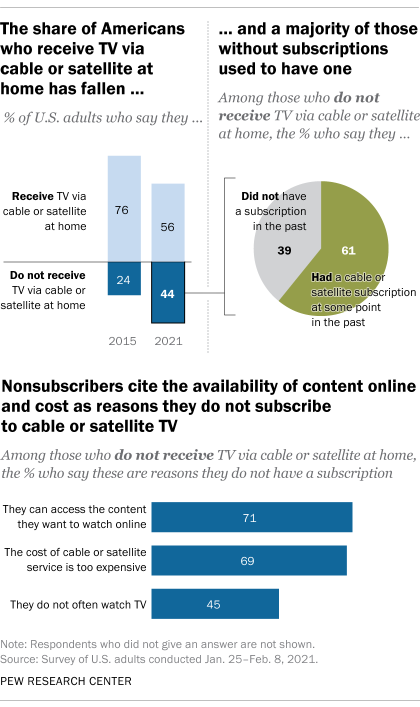Lesson 27 Quiz Continued a Cable Company Surveyed in Two Different Areas
The share of Americans who say they watch television via cable or satellite has plunged from 76% in 2015 to 56% this year, according to a new Pew Research Center survey of U.S. adults. Some 71% of those who do not use cable or satellite services say it's because they can access the content they want online, while 69% say the cost of cable and satellite services is too high and 45% say they do not often watch TV.
Pew Research Center regularly studies the changing information and media ecosystem in the United States. This report focuses on Americans' usage of different platforms to watch TV content. For this analysis, we surveyed 1,502 U.S. adults from Jan. 25 to Feb. 8, 2021, by cellphone and landline phone. The survey is weighted to be representative of the U.S. adult population by gender, race, ethnicity, education and other categories. Here are the questions, responses and methodology used for this report.

The drop in cable and satellite subscribers highlights the changing landscape of connectivity and media in an era of "cord cutting," particularly as internet streaming services like Netflix and Hulu have grown in popularity, especially during the COVID-19 pandemic.
Among those who do not currently subscribe to cable or satellite TV, 61% report that they had done so in the past, while 39% say they have never been subscribers. When applying these findings to the population as a whole, this means 27% of U.S. adults are "cord cutters" and 17% have never had a cable or satellite subscription, according to the survey, which was conducted Jan. 25-Feb. 8, 2021.
The decline in cable and satellite TV subscribers since 2015 shows up across the demographic spectrum (see detailed table). The trends among different age groups are particularly striking.


Only about a third (34%) of Americans ages 18 to 29 now get TV through cable or satellite, down 31 percentage points from 2015. Fewer than half (46%) of those ages 30 to 49 currently get TV that way, down 27 points. Among those 50 and older, the decline has been less dramatic: Those ages 50 to 64 saw a 14-point drop since 2015. Those 65 and older saw a 5-point decline, which is not a statistically significant difference.
Not only do young adults stand out for not using cable or satellite TV, they are also much more likely than their elders to have never gotten TV at home via cable or satellite – and to say they don't subscribe because they can find the content they want online.
Some 61% of those who are ages 18 to 29 and don't currently receive TV by cable or satellite say they did not do so in the past, compared with around three-in-ten in older age groups. And 91% of nonsubscribers in this age group say a reason they do not subscribe is that they can access the content they want online – again a considerably larger share than among older nonsubscribers.

About half (53%) of nonsubscribers ages 18 to 29 say a reason they do not have cable or satellite service at home is because they do not often watch television. That compares with a similar share (47%) of nonsubscribers ages 30 to 49 and a third of those 50 and older.
A bigger hindrance to older Americans is cost. Nearly eight-in-ten nonsubscribers ages 50 and older say a reason they do not have cable or satellite service is that it is too expensive. Around seven-in-ten (72%) nonsubscribers ages 30 to 49 say the same thing, but the share who say this is smaller (57%) among nonsubscribers ages 18 to 29.
These changes in the media landscape have been unfolding after cable service in the United States hit peak market penetration about a decade ago. The move to streaming services has been accompanied by the rise of mobile connectivity through smartphones, the rise of app-based streaming services and smart TVs. Industry-targeted research last summer showed that 55% of U.S. households have two or more streaming services.
CORRECTION (March 2021): A previous version of this post incorrectly listed partisan affiliation as a way in which the survey is weighted to be representative of the U.S. population. None of the study findings or conclusions are affected.
Note: Here are the questions, responses and methodology used for this report.

Lee Rainie is director of internet and technology research at Pew Research Center.
Source: https://www.pewresearch.org/fact-tank/2021/03/17/cable-and-satellite-tv-use-has-dropped-dramatically-in-the-u-s-since-2015/
0 Response to "Lesson 27 Quiz Continued a Cable Company Surveyed in Two Different Areas"
Publicar un comentario